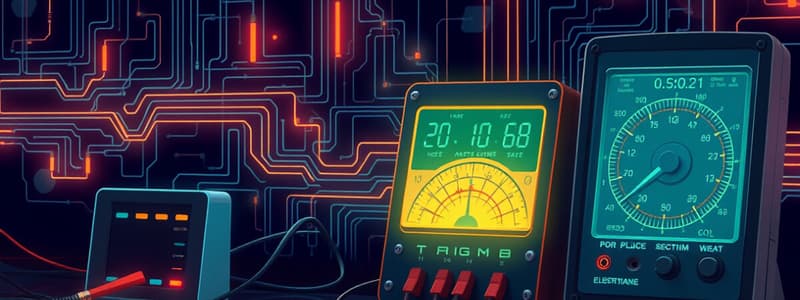Podcast
Questions and Answers
What component is essential for current to flow in a simple electric circuit?
What component is essential for current to flow in a simple electric circuit?
- Fuse
- Battery (correct)
- Ammeter
- Switch
Which unit of measurement is used for current in an electric circuit?
Which unit of measurement is used for current in an electric circuit?
- Volt
- Watt
- Ohm
- Ampere (correct)
What function does a voltmeter serve in an electric circuit?
What function does a voltmeter serve in an electric circuit?
- Measures resistance
- Measures power consumption
- Measures current flow
- Measures voltage (correct)
Which of the following statements about resistance is correct?
Which of the following statements about resistance is correct?
Which device can measure voltage, current, and resistance?
Which device can measure voltage, current, and resistance?
What is the primary function of a voltmeter in a circuit?
What is the primary function of a voltmeter in a circuit?
Which unit is used to measure electrical current?
Which unit is used to measure electrical current?
What happens in a circuit when there is very little resistance?
What happens in a circuit when there is very little resistance?
How is resistance measured in a circuit?
How is resistance measured in a circuit?
What does the symbol 'I' represent in electrical terms?
What does the symbol 'I' represent in electrical terms?
What is the primary use of an ammeter in an electric circuit?
What is the primary use of an ammeter in an electric circuit?
How should an ohmmeter be connected when measuring resistance?
How should an ohmmeter be connected when measuring resistance?
What is the difference between a parallel circuit and a series circuit?
What is the difference between a parallel circuit and a series circuit?
What precaution should be taken when using an ohmmeter?
What precaution should be taken when using an ohmmeter?
Which statement about a multimeter is correct?
Which statement about a multimeter is correct?
What is the consequence of a short circuit in an electrical circuit?
What is the consequence of a short circuit in an electrical circuit?
What are the implications of having a closed circuit in terms of electron flow?
What are the implications of having a closed circuit in terms of electron flow?
In which orientation should a voltmeter be connected to measure voltage across a load?
In which orientation should a voltmeter be connected to measure voltage across a load?
Which of the following statements accurately describes the relationship among voltage, current, and resistance?
Which of the following statements accurately describes the relationship among voltage, current, and resistance?
What does the symbol 'R' represent in electrical terminology?
What does the symbol 'R' represent in electrical terminology?
Why is it important to use safety precautions when working with measuring instruments in electric circuits?
Why is it important to use safety precautions when working with measuring instruments in electric circuits?
Which unit of measurement corresponds to electromotive force in an electrical circuit?
Which unit of measurement corresponds to electromotive force in an electrical circuit?
What role does an ohmmeter play in relation to circuit components?
What role does an ohmmeter play in relation to circuit components?
Which of the following statements about current in a circuit with low resistance is correct?
Which of the following statements about current in a circuit with low resistance is correct?
Which statement correctly describes the function of a voltmeter in a circuit?
Which statement correctly describes the function of a voltmeter in a circuit?
What is the main reason for connecting an ammeter in series in a circuit?
What is the main reason for connecting an ammeter in series in a circuit?
In which scenario would you use an ohmmeter safely?
In which scenario would you use an ohmmeter safely?
What describes the correct function of a multimeter?
What describes the correct function of a multimeter?
What occurs in a parallel circuit regarding the current?
What occurs in a parallel circuit regarding the current?
Which device is specifically designed to measure how much current flows through components when connected?
Which device is specifically designed to measure how much current flows through components when connected?
Study Notes
Electric Circuits
- An electric circuit is a pathway for electric current to flow, composed of multiple components.
- A simple circuit includes a source of electromotive force (emf), a load with resistance, conducting wires, and additional components like switches or fuses.
- Circuits can be open (off) or closed (on), affecting the flow of current.
Basic Electrical Quantities
- Three fundamental electrical quantities are:
- Voltage (V): The force driving current; measured in volts (V).
- Current (I): The flow of electric charge; measured in amperes (A).
- Resistance (R): The opposition to current flow; measured in ohms (Ω).
- High current due to low resistance, like in a short circuit, can lead to equipment damage.
Measuring Instruments
- Voltmeter:
- Measures emf or voltage across components; connected in parallel.
- Symbol: V.
- Ammeter:
- Measures current flowing in a circuit; connected in series.
- Symbol: A.
- Ohmmeter:
- Measures resistance; connected in parallel and must be used with power off.
- Symbol: Ω.
Multimeter
- A multimeter can measure voltage, current, and resistance; useful for diagnosing electrical issues.
- Two types:
- Analogue multimeter: Features an indicator needle.
- Digital multimeter: Displays measurements numerically on an LCD.
- Measurement requires switching between settings with a rotating switch and uses probes for connections.
Safety Precautions
- Always exercise safety when handling measuring instruments.
- Be cautious when measuring resistance or voltage, as improper use may cause electric shock or instrument damage.
Electric Circuits
- An electric circuit is a pathway for electric current to flow, composed of multiple components.
- A simple circuit includes a source of electromotive force (emf), a load with resistance, conducting wires, and additional components like switches or fuses.
- Circuits can be open (off) or closed (on), affecting the flow of current.
Basic Electrical Quantities
- Three fundamental electrical quantities are:
- Voltage (V): The force driving current; measured in volts (V).
- Current (I): The flow of electric charge; measured in amperes (A).
- Resistance (R): The opposition to current flow; measured in ohms (Ω).
- High current due to low resistance, like in a short circuit, can lead to equipment damage.
Measuring Instruments
- Voltmeter:
- Measures emf or voltage across components; connected in parallel.
- Symbol: V.
- Ammeter:
- Measures current flowing in a circuit; connected in series.
- Symbol: A.
- Ohmmeter:
- Measures resistance; connected in parallel and must be used with power off.
- Symbol: Ω.
Multimeter
- A multimeter can measure voltage, current, and resistance; useful for diagnosing electrical issues.
- Two types:
- Analogue multimeter: Features an indicator needle.
- Digital multimeter: Displays measurements numerically on an LCD.
- Measurement requires switching between settings with a rotating switch and uses probes for connections.
Safety Precautions
- Always exercise safety when handling measuring instruments.
- Be cautious when measuring resistance or voltage, as improper use may cause electric shock or instrument damage.
Studying That Suits You
Use AI to generate personalized quizzes and flashcards to suit your learning preferences.
Description
Test your understanding of electric circuits and the essential electrical quantities like voltage, current, and resistance. This quiz also covers measuring instruments used in electrical systems, including voltmeters and ammeters. Assess your knowledge and strengthen your grasp on these fundamental concepts.




